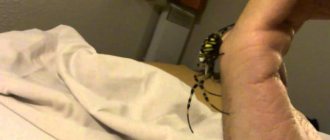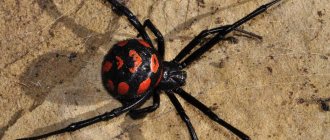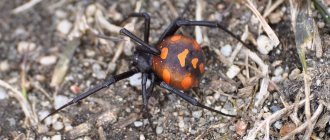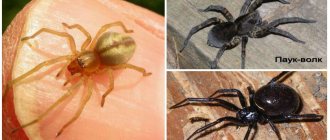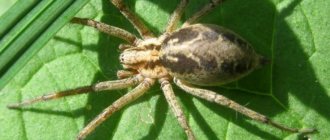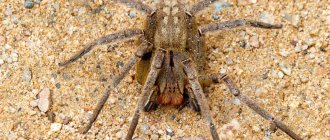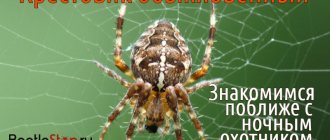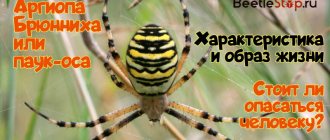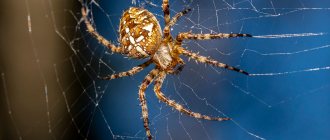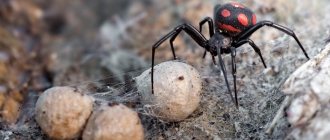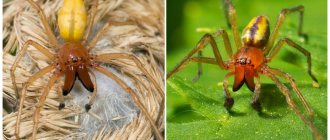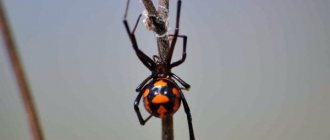The Argiope bruennichi or wasp spider is a common spider that stands out for its bright colors. Arthropods differ from other spiders in their way of life. Such factors have led to the fact that this animal is increasingly kept as an exotic pet.
The spider received this name in honor of the Danish zoologist Morten Trane Brünnich.
Spider wasp or Agryope Brunnich, appearance
What does the Argiope bruennicha spider look like?
Argiope spider.
Description of the spider
Name: Argiope bruennichi Lat.:
Argiope bruennichiClass: Arachnida - Arachnida Order: Spiders - Araneae Family: Orb-weaving spiders - Araneidae
| Habitats: | edges, forests and lawns |
| Dangerous for: | small insects |
| Attitude towards people: | harmless, do not harm |
This type of spider is difficult to confuse with others. The bright color of the abdomen, consisting of alternating transverse stripes of black and yellow, is very similar to the color of a wasp. At the same time, females and males of this species differ markedly from each other.
Thanks to the characteristic stripes, Agryope began to be called the wasp spider, zebra spider or tiger spider.
Appearance of the male
Female individuals have a bright pattern with clear lines on the abdomen, and the cephalothorax is densely covered with silver-colored villi. The length of their body can reach 2-3 cm. The walking legs are painted beige and decorated with pronounced black rings.
Appearance of the female
Agriopa males are significantly smaller than females. Their body reaches no more than 5 mm in length. The color of the abdomen is in light gray and beige shades. The rings on the legs are faint, blurred and gray or brown. On the outermost segments of the tentacles are the male genital organs - cymbiums.
Appearance
The body is divided into the abdomen and cephalothorax, which are connected to each other by a thin stalk. The cephalothorax is covered with a durable chitinous layer that protects it from mechanical damage.
Inside it is the brain and stomach. 4 pairs of walking legs, a pair of pedipalps and a pair of chelicerae extend from it. The limbs are thin and long. They help the spider deftly move along the shaky threads of the web. The pedipalps are used for touching and grasping prey.
The spider has 8 eyes, which are located on the front of the cephalothorax . One pair is especially large, located on top. Others are smaller, located in front and to the side of the largest pair.
There are also chelicerae that end in sharp curved fangs. Venom glands approach the fangs. On the last pair of legs there are special appendages, which consist of a layer of bristles.
They are used for weaving multilayer networks with complex patterns. With their help, the spider arranges its webs into the patterns it needs. This is a characteristic feature of all orb weavers. At the back of the lower part of the abdomen there are arachnoid appendages.
The tiger spider is famous for its strong sexual dimorphism. The body of females reaches 1.5 cm in length, males rarely grow more than 5 mm. The female's paw span can reach 4 cm.
Females boast a brighter color, which is designed to indicate the poisonousness of the spider and scare away predators. The abdomen is black with yellow stripes, sometimes white stripes can be seen on it. The fourth dark stripe from the cephalothorax has two wavy bends.
The coloring resembles that of a wasp. The abdomen is round in shape and has 4 concave sections. The cephalothorax is covered with gray hairs that shimmer in the light. The legs are long, black with yellow stripes. The pedipalps are long and light colored.
Males have an elongated long abdomen. The body is light brown in color. On the back, against a light background, two parallel dark stripes are visible.
On the long legs you can see sparse black bristles. At the ends of the pedipalps there are small thickenings - bulbs. The male does not at all resemble a wasp in appearance, so its species affiliation is more difficult to determine at first glance.
Features of reproduction
A pair of Argiope spiders.
Sexual maturity of the female occurs immediately after molting. Males try to mate with the female as quickly as possible, before her chelicerae become hard enough. During the mating process, males very often lose one of the bulbs, which makes it weaker and more vulnerable. After mating is completed, the large and aggressive female most often tries to attack the male and eat him.
After fertilization, the female begins to prepare a protective cocoon in which she lays mature eggs. One brood of the Agriopa spider can include up to 200-400 cubs. The new generation is born around the end of August - beginning of September.
Lifestyle of the Agryope spider
In the wild, representatives of this species can form small colonies of up to 20 individuals. The Agriopa spider is most attracted to open, well-lit areas. This type of arthropod can be found in clearings, lawns, forest edges and along roads.
How the spider Agriope weaves a web
Like other spiders of the orb-weaving family, Agryope weaves a very beautiful pattern on its web. In the center of its web, the wasp spider has a zigzag pattern of dense threads, which is called the stabilimentum. The stabilimentum has two purposes:
- This multi-layered pattern perfectly reflects the sun's rays and can be used to attract insects.
- Sensing the approach of danger, the spider Agryope begins to shake its webs. Because of this, the rays reflected by the web merge into one bright spot, which scares off a potential enemy.
Spider wasp in its web.
It is worth noting that the wasp spider weaves its webs exclusively at dusk. It takes Agriopa about an hour to weave a new circular web with a characteristic pattern.
After the web is ready, the female positions herself in the center and spreads her paws wide. At the same time, the first two and last two pairs of limbs are kept closer to each other, which is why the outline of the spider resembles the letter “X”.
Diet of the wasp spider
Spiders of this species are not particularly picky about food and their menu may include:
- grasshoppers;
- flies;
- mosquitoes;
- crickets;
- bugs;
- locusts
As soon as an insect gets caught in Agriopa’s net, she quickly rushes towards her, injects her paralyzing poison into the victim’s body and entangles him in a web. After some time, all the internal organs of the caught insect, under the influence of enzymes, turn into liquid, which the spider safely sucks out.
Natural enemies of the Agriopa spider
Due to its bright coloring, the wasp spider may not be afraid of most bird species, since the contrasting stripes on the abdomen scare away these feathered hunters. Agryope also rarely becomes a victim of predatory insects and other arachnids.
Argiope spider.
The most dangerous enemies of spiders of this species are:
- rodents;
- lizards;
- frogs;
- wasps;
- bees.
Nutrition
The Argiope's fishing net is distinguished not only by its beautiful shape and design, but also by its meticulous execution. In particular, the small size of individual cells. Even the smallest mosquito cannot break through such “windows”. Therefore, her lunch consists of unfortunate insects that got caught in this net.
It feeds on Orthoptera and various other insects. These are grasshoppers, crickets, grasshoppers (locusts), butterflies, midges, quails and jumpers. And also flies, bees, mosquitoes. The victim does not see the spider, or mistakes it for a wasp that is hovering in the air. The spider in the center of the web often repeats the shape of the stabilimentum and merges with it, only the striped body is visible. The prey begins to fight in the web, the signal thread gives a sign to the predator.
Argiope envelops prey in a cocoon and bites the victim
He quickly runs up to his prey and injects his paralyzing poison. Then he wraps the poor fellow in a cocoon and drags him to a secluded place. After a short time, it draws out juices from the body that has begun to dissolve. By the way, at home he eats the same as in captivity. Food should be given once every two days. Just, despite his love for dry climates, do not forget to give him water. And sometimes spray water into the aquarium on especially hot days.
How dangerous is the Agriope spider for humans?
The venom of the Agriopa spider is not highly toxic. Animals use it to cause paralysis in small insects caught in their nets. Based on experiments conducted by scientists, it was proven that the entire supply of poison of one female Agriopa is not enough to kill an adult black cockroach.
The Agriope spider is not prone to aggression and, sensing the approach of danger, it leaves its web and runs away. Agriope can attack a person only if she is driven into a corner or when trying to pick up an arthropod.
The bite of a wasp spider can be dangerous for small children or if a person is prone to allergic reactions to insect bites. For a healthy adult, an Agriope bite is not fatal, but can lead to the following symptoms:
- acute pain at the site of the bite;
- swelling and redness of the skin;
- severe itching.
Are you afraid of spiders?TerribleNo
If the reaction to the bite is more severe, you should immediately seek help. The help of a specialist is definitely needed for symptoms such as:
- severe increase in body temperature;
- dizziness;
- nausea;
- the appearance of severe swelling.
Karakurt bites
1806.15 Admin
Female and male karakurt
Among the victims of karakurt bites there are people of all ages, students and housewives. Agricultural workers most often suffer from karakurt bites. According to our data, the largest number of karakurt bites (52.3 percent) were observed among collective farmers and MTS workers of various specialties (tractor drivers, combine operators, trailer operators, shepherds, milkmaids, grooms, etc.)" During agricultural work, a significant number of karakurt lairs are destroyed, and the Karakurts are forced to look for new shelters. Looking for a new home, a spider can meet a person and bite him (being accidentally crushed) while working, sleeping at night or resting during the day in the field. The karakurt biting season remains largely constant from year to year (from May to September), but it may begin a week or two earlier or later depending on the weather conditions of each year, which can speed up or delay the emergence of spiders from cocoons. Thus, in the Alma-Ata region in 1950 and 1952. bites were recorded in the third ten days of May, and in 1949 and 1951 - in the first ten days of June. The frequency of bites varies throughout the season. It is characterized by two rises: in mid-June and July. These rises should be explained by the travels of the spider associated with the mating season and changes in habitats. Karakurt bites most often occur at night. According to our data, 61.4 percent of victims were bitten at night. Bites occurred under a variety of circumstances: in a hut, in a yurt, in an adobe house (on an earthen floor, on a wooden bench, on a bed), in a tent, in a stable, in a meadow, on straw near a combine, on a threshing floor, in hay near a house , on kurai, etc. Many people incorrectly think that karakurt specifically looks for a person and attacks him. In fact, during a journey, a karakurt accidentally crawls into the bed of a sleeping person and, only when pinned down, bites in self-defense. Karakurt bites in a hut, yurt, tent, stable and in open areas should be explained by the spider accidentally crawling onto a sleeping person. Bites in the house depend on the spider accidentally crawling through open doors or entering the house with grass, straw or hay brought from the steppe, as well as bedding after airing. Karakurt bites during the day, according to our data, occurred under the following circumstances: during hay harvesting (cutting hay, collecting, carrying and stacking), while working in the garden (weeding beets and corn, hilling potatoes, loading cabbage), during stacking bread, when putting on clothes into which a karakurt crawled, while washing clothes near a river, etc. It is appropriate to recall an interesting incident from the history of the study of karakurt. In 1899, a special expedition was sent to Turkestan, one of the tasks of which was to study the toxic properties of karakurt poison. One of the expedition members took the spider in his hands, and it crawled freely along his hand, without causing any harm. The expedition staff were ready to conclude that the karakurt was harmless when one of the participants accidentally crushed it. The karakurt immediately bit, and soon after that severe poisoning developed. Karakurt can bite a person in any part of the body. The majority of bites occurred on the upper and lower extremities (upper 29.9 and lower 38.4 percent), with no noticeable difference in the involvement of the right and left lower extremities. The right and left shoulders are almost equally susceptible to bites, while the right forearm and right hand are affected almost three times more often than the left. Bites to the torso were observed in 21.2 percent of patients. There is a certain pattern in the localization of daytime bites, associated with the conditions under which the bite was inflicted - during work or during rest. The largest number of bites during agricultural work occurs on the lower leg and forearm, while during rest - on the torso and thigh. There is still an opinion that the severity of poisoning by karakurt poison depends on the location of the bite, that is, supposedly the closer the bite is to the head, the more severe the disease. The facts do not support this opinion. Two patients bitten on the extremity experienced facial paralysis, while no such complications were observed in patients bitten on the face. The clinical picture of poisoning with karakurt poison in patients, described at different times by different authors, in different geographical areas, reveals a great similarity of leading symptoms. In the clinical picture of poisoning, it is customary to distinguish between local and general phenomena. Local phenomena are usually very diverse. They can be expressed in the form of redness of the bite site with swelling to varying degrees, the appearance of a vesicle filled with clear liquid, etc. Often at the site of the bite it is not possible to note not only signs of inflammation, but even traces of the bite. The severe clinical picture of poisoning from a karakurt bite puts local phenomena in second place. General phenomena with a karakurt bite should be considered basic. Although the signs of poisoning after a bite are very diverse, the clinical picture of the disease is very characteristic. The disease, as a rule, begins suddenly and extremely acutely in a completely healthy person. The burning pain that occurs at the site of the bite after 15 - 20 minutes almost perceptibly spreads to neighboring parts of the body and organs. After 20 - 40 minutes, chills, pain in the chest, abdomen and especially in the limbs appear, as well as a burning sensation throughout the body. Severe weakness develops, sometimes depriving the patient of the ability to move independently. Strong excitement appears and, what is especially characteristic, fear of death. Breathing is difficult. The pulse becomes frequent, heart sounds are muffled; blood pressure initially rises. Urinary retention occurs. Some patients experience drooling and difficulty swallowing. After three hours, cramps of the lower and upper extremities appear. Later, four to five hours after the bite, nausea, vomiting, tension in the rectus abdominis muscles and constipation appear. The tongue, remaining wet, becomes covered with a white coating. After 8-10 hours, there is a puffiness of the face, swelling of the eyelids and heavy sweating, which is combined with chills. The temperature is low-grade (from normal to 38°), less often normal or high. Significant changes occur in the blood. With the disappearance of symptoms of poisoning, the patient's condition gradually improves. During the recovery period, usually on the third or fourth day of the disease, a profuse polymorphic itchy rash appears on the skin of the chest, abdomen and limbs, disappearing without a trace after three to four days. The disease lasts from three to ten days. After discharge from the hospital, patients remain incapacitated for 5-15 days due to severe weakness.
What are the consequences of karakurt bites? Since ancient times, among the population there has been an opinion that karakurt bites are fatal. In fear of the spider, nomads abandoned areas rich in vegetation and went many thousands of kilometers away. In 1899, K. N. Rossikov (a Russian researcher who studied karakurt on the territory of present-day Kazakhstan), traveling in the Syr-Darya region, saw areas with rich vegetation left by nomads who fled in fear of karakurt to the borders of China. Unfortunately, such the view can still often be found in literature. True, in recent years, many have begun to consider the stories about the mortality of karakurt bites to be significantly exaggerated. Deaths after karakurt bites still occur, but very rarely and only in cases where the victims do not receive medical care. According to our data, out of 233 people bitten by karakurts, not a single death was observed, although among the victims there were 12 children, including one infant. The good outcome of the disease in these patients can be explained by timely medical care. Nowadays, when medical care is as close as possible to the population, the likelihood of death from a karakurt bite is negligible. We studied the long-term consequences of karakurt bites in 50 people at various intervals after the bites. The most common consequences of karakurt bites were general weakness and fatigue, pain in the limbs, heart and lower back, headaches and dizziness, shortness of breath and palpitations, poor sleep and appetite. Some people experienced periodic rashes, decreased hearing, sexual impotence, etc. These phenomena lasted for varying periods of time after the bite (from one week to one year or longer). Victims of a karakurt bite, who did not receive timely medical care due to the significant distance of their place of work from medical institutions, subsequently often sought medical help, but with complications after the bite.
First aid. Immediately after the bite (no later than two to three minutes), it is necessary to cauterize the bite site with the flame of a flammable match. Cauterization is done as follows: a match is applied with the head to the bite site and set on fire with another match. This method, proposed by [Professor P.I. Marikovsky, based on the rapid destruction of karakurt poison when heated. Since karakurt bites into the most superficial layers of the skin no deeper than 0.5 mm, the flame of a flammable match is enough to destroy the poison. Why is cauterization beneficial when done no later than 2 to 3 minutes after the bite, and how is this time determined? In 1949, P.I. Marikovsky studied the absorption of karakurt poison in an experiment on guinea pigs. For this purpose, karakurt was planted on the shaved surface of the skin of a guinea pig. After a karakurt bite, the area of skin that was bitten was cut out at various intervals. This experiment showed that after one minute the poison caused mild poisoning, after two minutes it caused severe poisoning, and after five minutes it caused the death of the animal. This experiment proved that karakurt poison is absorbed very quickly, and a conclusion was made about the effectiveness of local treatment only immediately after the bite.
Medical assistance. A victim of a karakurt bite, for whom cauterization was not done or was done late, must be taken to a medical facility as soon as possible. It is customary to distinguish between local and general treatment. Local treatment for a karakurt bite is of secondary importance and comes down to injecting the bite site with a 0.25 percent solution of novocaine (10 - 15 ml). We believe that novocaine blockade should be used even if the patient is admitted late. Among the means of general treatment, it is best to use a specific antikarakurt serum. In the absence of the latter, it is good to prescribe intravenously a 33% solution of wine alcohol, 10-12 ml, three to four times a day during the first or second day of the disease. You can prescribe intravenously a one percent solution of novocaine, 10 ml, or a two to three percent solution of potassium permanganate in an amount of 3-5 ml. In addition to these remedies, symptomatic treatment is also used. There are no radical measures to combat karakurt to date. The spider's spread over a large area and its resistance to chemicals create great difficulties in combating it. Since ancient times, people have resorted to various methods of protection against the bites of poisonous spiders. In 1785, the Russian traveler Gmelin wrote that there is a belief among the population that the karakurt is afraid of the smell of sheep feces, so nomads, in order to protect themselves from bites, settle down in former sheep camps. There are indications in the literature that nomads, when stopping for a camp, first drive the sheep through the place chosen for the night. When laying down for the night, they spread sheep skins under them, the smell of which the karakurt supposedly cannot stand. They also use digging around the parking area with a ditch into which water is poured, surrounding the parking area with a rope through which the karakurt does not crawl, etc. However, all of the listed methods of protection against bites, based on preventing the karakurt from crawling into the roosting area, turned out to be unsuitable. This is evidenced by karakurt bites in yurts, where there are felts and skins, bites near the river, etc. Consequently, neither a felt, nor a sheep skin, nor a hair rope, nor a water obstacle can stop a traveling female karakurt. However, you can protect yourself from a karakurt bite if you take some precautions. To do this, it is recommended not to walk barefoot during summer field work, wear trousers tucked into socks, and not lie on the ground without a bedding (which can be a tarpaulin, felt mat, etc.). When spending the night in the field, you should use gauze canopies as the most effective means of protection from the spider; keep your clothes in the canopy, as a spider can crawl into it and bite while dressing.
Habitat of the Agryope Brünnich spider
This type of spider prefers steppe and desert zones. Their habitat covers almost the entire Palearctic region. Agryope Brünnich can be found in the following regions:
- Southern and Central Europe;
- North Africa;
- Asia Minor and Central Asia;
- Far East;
- Japanese islands.
In Russia, the wasp spider is found mainly in the southern part of the country, but every year representatives of this species are increasingly found in more northern regions. At the moment, you can encounter Agriopa in Russia in the following areas:
- Chelyabinskaya;
- Lipetskaya;
- Orlovskaya;
- Kaluzhskaya;
- Saratovskaya;
- Orenburgskaya;
- Samara;
- Moscow;
- Bryansk;
- Voronezh;
- Tambovskaya;
- Penza;
- Ulyanovskaya;
- Novgorodskaya;
- Nizhny Novgorod.
Interesting facts about the spider Agryope
The wasp spider attracts the attention of many people not only because of its unusual and bright color, but also due to several interesting features:
- After hatching from the egg, the young generation disperses by flying on their own webs. Like “flying carpets,” their networks pick up air currents and carry them over vast distances. According to scientists, it is precisely such flights that are the reason for the colonization of more northern regions by this species.
- Agyriope thrives in captivity and this makes them very easy to keep in terrariums. In this case, it is very important to place only one spider inside, since these creatures will not share their living space with neighbors. When it comes to feeding, the wasp spider is also unpretentious. It is enough to leave him special insects from the pet store at least every other day.
Steps
Recognizing Poisonous Spiders
Determine if it's crawling on your arm.
When it comes to spider identification, the first thing to rule out is the brown recluse spider. It is the most dangerous spider in the United States and is most common in the Southeast and Midwest. A brown recluse bite can cause an infection, which may require medical attention. Here's how to tell if the spider you find is a brown recluse:
Do your research to find out the type of spider.
Memorize or write down the spider's appearance, and if you have time, look at the World Spider Catalog, the Online Journal of Arachnology, and other expert-compiled online sources to find the spider you're looking for and compare it with pictures of other species.
WikiHow also has useful articles about spiders. More information can be found in the articles “How to identify a garden spider”, “How to identify a barn spider”, “How to identify a redback spider”, “How to recognize a tarantula spider”.
Taking into account other basic factors
Make sure it's really a spider. Many people think that spiders are insects, but in fact this is not true at all. To make sure that the creature you meet is really a spider, you should pay attention to the following:
Two body segments. Unlike insects, which have three body segments, spiders have only two. Eight legs Do not confuse antennae and legs. Lack of wings. No spider has wings
No matter how much a creature resembles a spider, if it has wings, it is not a spider.
Spider (lat. Araneae) belongs to the phylum arthropod, class Arachnida, order Spiders. Their first representatives appeared on the planet approximately 400 million years ago.
